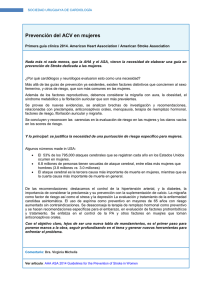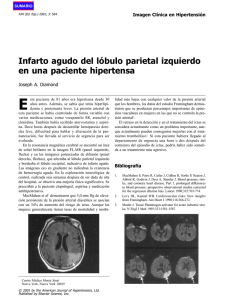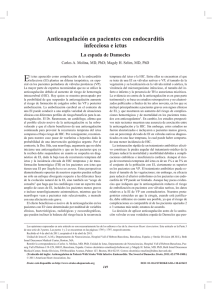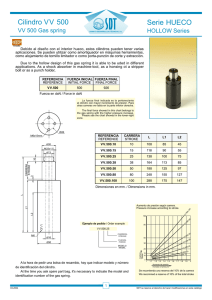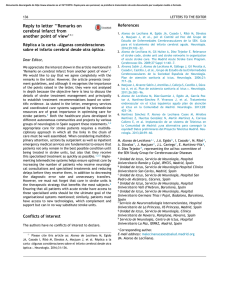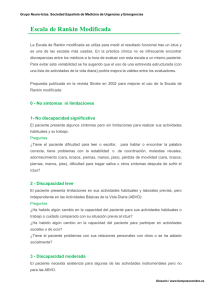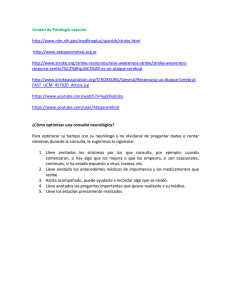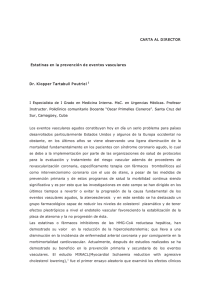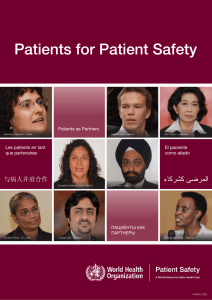Anticoagulation in Patients With Stroke With Infective Endocarditis
Anuncio
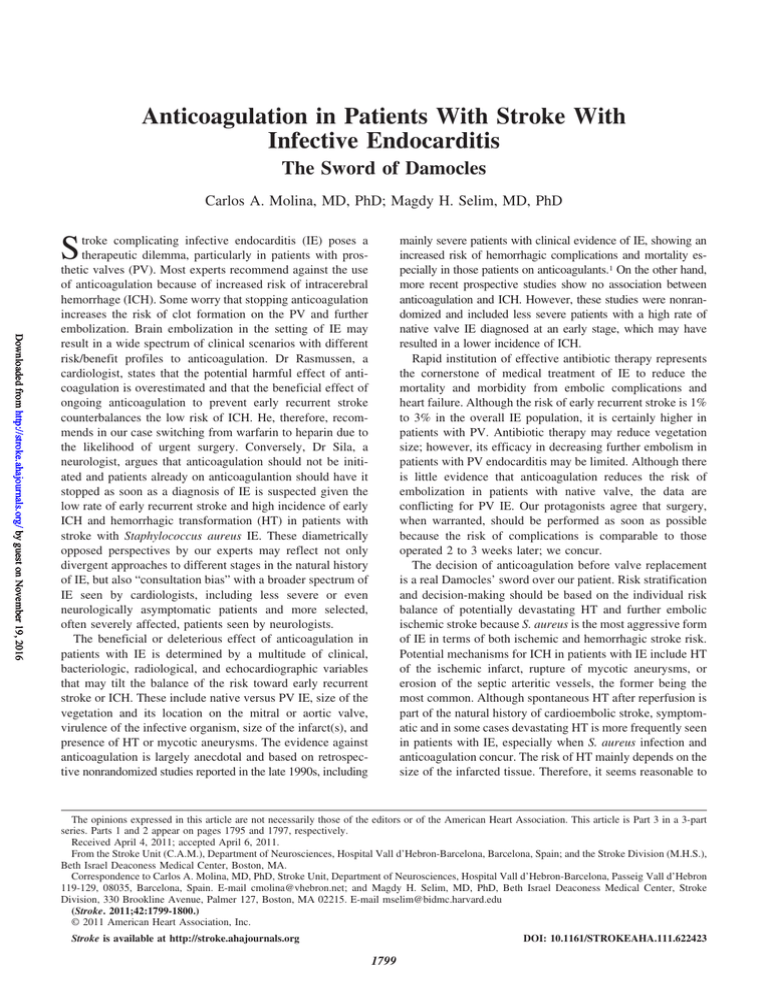
Anticoagulation in Patients With Stroke With Infective Endocarditis The Sword of Damocles Carlos A. Molina, MD, PhD; Magdy H. Selim, MD, PhD S Downloaded from http://stroke.ahajournals.org/ by guest on November 19, 2016 troke complicating infective endocarditis (IE) poses a therapeutic dilemma, particularly in patients with prosthetic valves (PV). Most experts recommend against the use of anticoagulation because of increased risk of intracerebral hemorrhage (ICH). Some worry that stopping anticoagulation increases the risk of clot formation on the PV and further embolization. Brain embolization in the setting of IE may result in a wide spectrum of clinical scenarios with different risk/benefit profiles to anticoagulation. Dr Rasmussen, a cardiologist, states that the potential harmful effect of anticoagulation is overestimated and that the beneficial effect of ongoing anticoagulation to prevent early recurrent stroke counterbalances the low risk of ICH. He, therefore, recommends in our case switching from warfarin to heparin due to the likelihood of urgent surgery. Conversely, Dr Sila, a neurologist, argues that anticoagulation should not be initiated and patients already on anticoagulantion should have it stopped as soon as a diagnosis of IE is suspected given the low rate of early recurrent stroke and high incidence of early ICH and hemorrhagic transformation (HT) in patients with stroke with Staphylococcus aureus IE. These diametrically opposed perspectives by our experts may reflect not only divergent approaches to different stages in the natural history of IE, but also “consultation bias” with a broader spectrum of IE seen by cardiologists, including less severe or even neurologically asymptomatic patients and more selected, often severely affected, patients seen by neurologists. The beneficial or deleterious effect of anticoagulation in patients with IE is determined by a multitude of clinical, bacteriologic, radiological, and echocardiographic variables that may tilt the balance of the risk toward early recurrent stroke or ICH. These include native versus PV IE, size of the vegetation and its location on the mitral or aortic valve, virulence of the infective organism, size of the infarct(s), and presence of HT or mycotic aneurysms. The evidence against anticoagulation is largely anecdotal and based on retrospective nonrandomized studies reported in the late 1990s, including mainly severe patients with clinical evidence of IE, showing an increased risk of hemorrhagic complications and mortality especially in those patients on anticoagulants.1 On the other hand, more recent prospective studies show no association between anticoagulation and ICH. However, these studies were nonrandomized and included less severe patients with a high rate of native valve IE diagnosed at an early stage, which may have resulted in a lower incidence of ICH. Rapid institution of effective antibiotic therapy represents the cornerstone of medical treatment of IE to reduce the mortality and morbidity from embolic complications and heart failure. Although the risk of early recurrent stroke is 1% to 3% in the overall IE population, it is certainly higher in patients with PV. Antibiotic therapy may reduce vegetation size; however, its efficacy in decreasing further embolism in patients with PV endocarditis may be limited. Although there is little evidence that anticoagulation reduces the risk of embolization in patients with native valve, the data are conflicting for PV IE. Our protagonists agree that surgery, when warranted, should be performed as soon as possible because the risk of complications is comparable to those operated 2 to 3 weeks later; we concur. The decision of anticoagulation before valve replacement is a real Damocles’ sword over our patient. Risk stratification and decision-making should be based on the individual risk balance of potentially devastating HT and further embolic ischemic stroke because S. aureus is the most aggressive form of IE in terms of both ischemic and hemorrhagic stroke risk. Potential mechanisms for ICH in patients with IE include HT of the ischemic infarct, rupture of mycotic aneurysms, or erosion of the septic arteritic vessels, the former being the most common. Although spontaneous HT after reperfusion is part of the natural history of cardioembolic stroke, symptomatic and in some cases devastating HT is more frequently seen in patients with IE, especially when S. aureus infection and anticoagulation concur. The risk of HT mainly depends on the size of the infarcted tissue. Therefore, it seems reasonable to The opinions expressed in this article are not necessarily those of the editors or of the American Heart Association. This article is Part 3 in a 3-part series. Parts 1 and 2 appear on pages 1795 and 1797, respectively. Received April 4, 2011; accepted April 6, 2011. From the Stroke Unit (C.A.M.), Department of Neurosciences, Hospital Vall d’Hebron-Barcelona, Barcelona, Spain; and the Stroke Division (M.H.S.), Beth Israel Deaconess Medical Center, Boston, MA. Correspondence to Carlos A. Molina, MD, PhD, Stroke Unit, Department of Neurosciences, Hospital Vall d’Hebron-Barcelona, Passeig Vall d’Hebron 119-129, 08035, Barcelona, Spain. E-mail [email protected]; and Magdy H. Selim, MD, PhD, Beth Israel Deaconess Medical Center, Stroke Division, 330 Brookline Avenue, Palmer 127, Boston, MA 02215. E-mail [email protected] (Stroke. 2011;42:1799-1800.) © 2011 American Heart Association, Inc. Stroke is available at http://stroke.ahajournals.org DOI: 10.1161/STROKEAHA.111.622423 1799 1800 Stroke June 2011 Downloaded from http://stroke.ahajournals.org/ by guest on November 19, 2016 withdraw anticoagulation, at least temporarily, in patients with large territorial infarctions. However, patients with smaller infarcts are also at risk of ICH. Numerous cerebral microbleeds seen on T2*-weighted MRI are highly prevalent in patients with IE, which may reflect a subacute microvascular inflammation that heralds mycotic aneurysms.2 Therefore, emergent MRI evaluation, including diffusion-weighted imaging, MR angiography, and T2*-weighted sequences, may help to identify patients with IE at risk of hemorrhagic complications. On the other hand, extensive echocardiographic evaluation may help to identify those at risk of early recurrent embolism who require continuing anticoagulants. Large (⬎10 mm) and mobile vegetations have been associated with multiple brain and spleen embolisms. We agree that the risk of devastating ICH due to anticoagulation after IE-related stroke, particularly when small, may be overestimated; however, it is not nil. Therefore, we support a more conservative approach unless there is over- whelming evidence for high risk of recurrent embolization. There is certainly a need for randomized studies in patients with IE with stroke to determine the risk/benefit of anticoagulation using multimodal MRI and echocardiography for patient selection and stratification, but is this ever likely to occur? Disclosures None. References 1. Tornos P, Almirante B, Mirabet S, Permanyer G, Pahissa A, Soler-Soler J. Infective endocarditis due to Staphylococcus aureus. Deleterious effect of anticoagulant therapy. Arch Intern Med. 1999;159:473– 475. 2. Klein I, Iung B, Labreuche J, Hess A, Wolff M, Messika-Zeitoun D, Lavallée P, Laissy JP, Leport C, Duval X; IMAGE Study Group. Cerebral microbleeds are frequent in infective endocarditis: a case– control study. Stroke. 2009;40:3461–3465. KEY WORDS: anticoagulation 䡲 endocarditis Anticoagulation in Patients With Stroke With Infective Endocarditis: The Sword of Damocles Carlos A. Molina and Magdy H. Selim Downloaded from http://stroke.ahajournals.org/ by guest on November 19, 2016 Stroke. 2011;42:1799-1800; originally published online May 5, 2011; doi: 10.1161/STROKEAHA.111.622423 Stroke is published by the American Heart Association, 7272 Greenville Avenue, Dallas, TX 75231 Copyright © 2011 American Heart Association, Inc. All rights reserved. Print ISSN: 0039-2499. Online ISSN: 1524-4628 The online version of this article, along with updated information and services, is located on the World Wide Web at: http://stroke.ahajournals.org/content/42/6/1799 Data Supplement (unedited) at: http://stroke.ahajournals.org/content/suppl/2011/05/09/STROKEAHA.111.622423.DC1.html Permissions: Requests for permissions to reproduce figures, tables, or portions of articles originally published in Stroke can be obtained via RightsLink, a service of the Copyright Clearance Center, not the Editorial Office. Once the online version of the published article for which permission is being requested is located, click Request Permissions in the middle column of the Web page under Services. Further information about this process is available in the Permissions and Rights Question and Answer document. Reprints: Information about reprints can be found online at: http://www.lww.com/reprints Subscriptions: Information about subscribing to Stroke is online at: http://stroke.ahajournals.org//subscriptions/ Anticoagulación en pacientes con endocarditis infecciosa e ictus La espada de Damocles Carlos A. Molina, MD, PhD; Magdy H. Selim, MD, PhD E l ictus aparecido como complicación de la endocarditis infecciosa (EI) plantea un dilema terapéutico, en especial en los pacientes portadores de válvulas protésicas (VP). La mayor parte de expertos recomiendan que no se utilice la anticoagulación debido al aumento de riesgo de hemorragia intracerebral (HIC). Hay quien se muestra preocupado por la posibilidad de que suspender la anticoagulación aumente el riesgo de formación de coágulos sobre las VP y posterior embolización. La embolización cerebral en el contexto de una EI puede conducir a una amplia variedad de situaciones clínicas con diferentes perfiles de riesgo/beneficio para la anticoagulación. El Dr. Rasmussen, un cardiólogo, afirma que el posible efecto nocivo de la anticoagulación se ha sobrevalorado y que el efecto beneficioso de una anticoagulación continuada para prevenir la recurrencia temprana del ictus compensa el bajo riesgo de HIC. Por consiguiente, recomienda para nuestro caso pasar de warfarina a heparina dada la probabilidad de una intervención quirúrgica urgente. Por el contrario, la Dra. Sila, una neuróloga, argumenta que no debe iniciarse una anticoagulación y que en los pacientes que ya la reciben debe suspenderse en cuanto se sospecha un diagnóstico de EI, dada la baja tasa de recurrencia temprana del ictus y la incidencia elevada de HIC tempranas y de transformación hemorrágica (TH) en los pacientes con ictus que tienen una EI por Staphylococcus aureus. Estas perspectivas diametralmente opuestas de nuestros expertos pueden reflejar no sólo un enfoque divergente respecto a las diferentes fases de la evolución natural de la EI, sino también un “sesgo de consulta” que haga que los cardiólogos vean un espectro más amplio de casos de EI, incluidos los pacientes menos graves o incluso neurológicamente asintomáticos, mientras que los neurólogos vean a pacientes más seleccionados, a menudo con una afectación más grave. El efecto beneficioso o nocivo de la anticoagulación en los pacientes con EI viene determinado por multitud de variables clínicas, bacteriológicas, radiológicas y ecocardiográficas, que pueden inclinar la balanza del riesgo hacia la recurrencia temprana del ictus o la HIC. Entre ellas se encuentran el que se trata de una EI en válvulas nativas o VP, el tamaño de la vegetación y su localización en la válvula mitral o aórtica, la virulencia del microorganismo infeccioso, el tamaño del infarto o infartos y la presencia de TH o aneurismas micóticos. La evidencia en contra de la anticoagulación es en gran parte testimonial y se basa en estudios retrospectivos y no aleatorizados publicados a finales de los años noventa, en los que se incluyó principalmente a pacientes graves con signos clínicos de EI, y que mostraron un aumento del riesgo de complicaciones hemorrágicas y de mortalidad en los pacientes tratados con anticoagulantes1. En cambio, los estudios prospectivos más recientes muestran una ausencia de asociación entre la anticoagulación y la HIC. Sin embargo, estos estudios no fueron aleatorizados e incluyeron a pacientes menos graves, con un porcentaje elevado de EI en válvulas nativas diagnosticados en una fase temprana, lo cual puede haber comportado una menor incidencia de HIC. La instauración rápida de un tratamiento antibiótico efectivo constituye la piedra angular del tratamiento médico de la EI para reducir la mortalidad y morbilidad debidas a complicaciones embólicas e insuficiencia cardiaca. Aunque el riesgo de recurrencia temprana del ictus es de un 1% a un 3% en el conjunto de la población con EI, ciertamente es superior en los pacientes con VP. El tratamiento antibiótico puede reducir el tamaño de las vegetaciones; sin embargo, su eficacia para reducir el ulterior embolismo en los pacientes con endocarditis de VP puede ser limitada. Aunque hay pocas evidencias que indiquen que la anticoagulación reduzca el riesgo de embolización en pacientes con válvulas nativas, los datos relativos a la EI de VP son contradictorios. Nuestros protagonistas coinciden en que la cirugía, cuando está justificada, debe utilizarse en cuanto sea posible, ya que el riesgo de complicaciones es comparable al de los pacientes operados 2 o 3 semanas más tarde; estamos de acuerdo. La decisión de aplicar anticoagulación antes de la sustitución valvular es una verdadera espada de Damocles que pen- Las opiniones expresadas en este artículo no son necesariamente las de los editores o las de la American Heart Association. Este artículo es la Parte 3 de una serie de 3 partes. Las partes 1 y 2 se encuentran en las páginas 1795 y 1797, respectivamente. Recibido el 4 de abril de 2011; aceptado el 6 de abril de 2011. Unidad de Ictus (C.A.M.), Departamento de Neurociencias, Hospital Vall d’Hebron-Barcelona, Barcelona, España; y Stroke Division (M.H.S.), Beth Israel Deaconess Medical Center, Boston, MA. Remitir la correspondencia a Carlos A. Molina, MD, PhD, Unidad de Ictus, Departamento de Neurociencias, Hospital Vall d’Hebron-Barcelona, Passeig Vall d’Hebron 119-129, 08035, Barcelona, España. Correo electrónico [email protected]; y Magdy H. Selim, MD, PhD, Beth Israel Deaconess Medical Center, Stroke Division, 330 Brookline Avenue, Palmer 127, Boston, MA 02215. Correo electrónico [email protected] (Traducido del inglés: Anticoagulation in Patients With Stroke With Infective Endocarditis. The Sword of Damocles. Stroke, 2011;42:1799-1800.) © 2011 American Heart Association, Inc. Stroke está disponible en http://www.stroke.ahajournals.org DOI: 10.1161/STROKEAHA.110.622423 149 150 Stroke Noviembre 2011 de sobre el paciente. La estratificación del riesgo y la toma de decisiones deben basarse en un balance del riesgo individual de una posible TH devastadora y de un ulterior ictus isquémico embólico, ya que la EI por S. aureus constituye la forma más agresiva de EI en cuanto a riesgo de ictus tanto isquémico como hemorrágico. Los posibles mecanismos de producción de una HIC en pacientes con EI son la TH del infarto isquémico, la ruptura de aneurismas micóticos o la erosión de vasos con arteritis séptica; el primero de ellos es el más frecuente. Aunque la TH espontánea tras la reperfusión forma parte de la evolución natural del ictus cardioembólico, la TH sintomática, y en algunos casos devastadora, se observa con más frecuencia en pacientes con EI, sobre todo cuando coinciden la infección por S. aureus y la anticoagulación. El riesgo de TH depende principalmente del tamaño del tejido infartado. En consecuencia, parece razonable retirar la anticoagulación, al menos temporalmente, en los pacientes con infartos de un territorio amplio. Sin embargo, en los pacientes con infartos de menor tamaño hay también un riesgo de HIC. La presencia de numerosos microsangrados cerebrales observados en la RM con ponderación T2* tiene una alta prevalencia en los pacientes con EI, y ello puede reflejar una inflamación microvascular subaguda que anuncie la aparición de aneurismas micóticos2. En consecuencia, la exploración de RM de urgencia, incluidas las imágenes con ponderación de difusión, la angio-RM y las secuencias con ponderación T2*, puede ser útil para identificar a los pacientes con EI que tienen riesgo de complicaciones hemorrágicas. Por otro lado, un examen ecocardiográfico detallado puede ser útil para identificar a los pacientes con riesgo de recurrencia embólica temprana en los que es necesario continuar con el empleo de anticoagulantes. Las vegetaciones grandes (> 10 mm) y móviles se han asociado a los embolismos múltiples cerebrales y esplénicos. Estamos de acuerdo en que el riesgo de una HIC devastadora debida a la anticoagulación tras un ictus relacionado con la EI, en especial cuando es pequeño, puede haberse sobreestimado; sin embargo, no es nulo. En consecuencia, apoyamos un planteamiento más conservador, a menos que haya una evidencia abrumadora que indique un riesgo alto de recurrencia de la embolización. Ciertamente son necesarios estudios aleatorizados en pacientes con EI e ictus para determinar la relación riesgo/beneficio de la anticoagulación con el empleo de RM multimodal y ecocardiografía para seleccionar y estratificar a los pacientes, pero ¿es probable que lleguen a realizarse? Declaraciones Ninguno. Bibliografía 1. Tornos P, Almirante B, Mirabet S, Permanyer G, Pahissa A, Soler-Soler J. Infective endocarditis due to Staphylococcus aureus. Deleterious effect of anticoagulant therapy. Arch Intern Med. 1999;159:473– 475. 2. Klein I, Iung B, Labreuche J, Hess A, Wolff M, Messika-Zeitoun D, Lavallée P, Laissy JP, Leport C, Duval X; IMAGE Study Group. Cerebral microbleeds are frequent in infective endocarditis: a case– control study. Stroke. 2009;40:3461–3465. PALABRAS CLAVE: anticoagulation Q endocarditis
